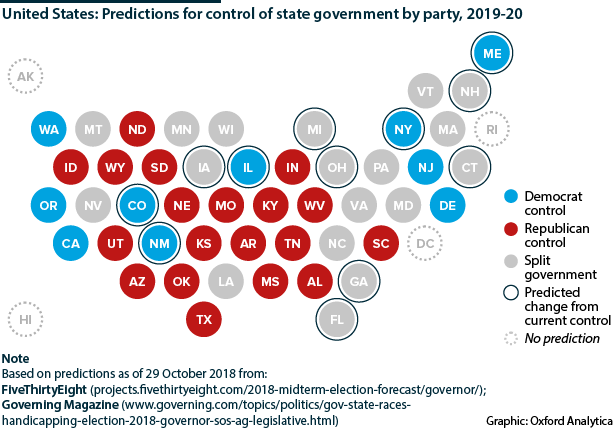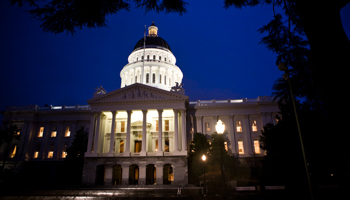US state election races to set 2019-21 policy stage
The outcomes of this year’s state elections will influence the electoral map beyond 2020
On November 6, as the nation votes in the federal midterm elections, a multitude of state officials will also be elected. These state elections have great significance for policy measures in 2019-20, particularly as Washington is expected to be gridlocked through divided control of Congress and the White House until 2020.
What next
Democrats are likely to gain gubernatorial seats in states including Florida, Illinois and Michigan and win full control of New York’s state government. This will see Democratic policies enacted in these states, especially as economic growth gives states new spending flexibility. However, the greatest impact may be the long-term balance of power in Congress. Since redistricting will happen after 2020 when these governors will be incumbents, they could reverse the gerrymandering patterns that have granted the US House of Representatives a Republican bias since 2012.
Subsidiary Impacts
- The Georgia governor’s election could result in lengthy court battles over voters’ ability to cast their ballots.
- Evidence of foreign hacking of election systems could trigger new rounds of sanctions on culprit countries.
- Hacking would drive state governments to invest more in cybersecurity, as California, Michigan and Maryland have done.
Analysis
Election day will see 36 governors elected, alongside 30 state attorneys-general and 26 secretaries of state. Also to be elected are legislators for the House of Representatives in 45 states and 42 state Senates (see UNITED STATES: Governor races will shape Trump agenda - April 10, 2018).
Currently, there are trifectas (where one party controls the state's legislature and executive simultaneously) in 34 of the 50 US states. Eight of these trifectas are Democratic and 26 Republican. The Democrats hold 16 governorships and the Republicans 33.
34/50
Number of states under one party's controlForecasting November 6's results comes with different challenges from federal races: local media have less money for opinion polling, while smaller sample sizes of each district leave larger degrees of uncertainty.
Based on predictions from politics and statistics firm FiveThirtyEight and Governing magazine, in 2019-20, the Democrats may control ten states' governments and the Republicans 19, while split government (no party in overall control) is likely in 18 states.
Gerrymandering
Once the elections are complete, their most far-reaching national ramification will be for 're-districting' for the US Congress after the 2020 census, since this will be the map used for the 2022 elections. States must draw their districts for congressional office and, thus far, the Supreme Court has not established rules defining unconstitutional partisan gerrymandering, which both parties have performed.
After the 2010 election, Republicans in control of state governments after their landslide victories approved new maps that gave them additional seats. For example, in 2012, Michigan saw Democrats win more total votes for the US House of Representatives by 51% to 46% but win only five of 14 seats. Nationwide, Democrats won the popular vote in House elections by 49% to 48% but did not control the House.
Analysis from the Associated Press found that Republicans won as many as 22 additional House seats in the 2016 election due to gerrymandering (they would have lost control of the body with a 24-seat swing).
Gerrymandering is concentrated in larger states with closely divided state-wide electorates, and much of the impact occurred in Florida, Wisconsin, Michigan, North Carolina, Pennsylvania and Virginia. All these states may have Democratic governors in office in 2021, when the next redistricting occurs, and will veto maps that disadvantage their own parties, or pass laws creating independent commissions.
Presidential effects
A president's party traditionally loses seats in its first midterm elections. However, in the 2022 elections, Democrats would enjoy an advantage of 15-25 new House seats becoming structurally more favourable to them after Democratic governors prevented an additional round of gerrymandering.
Republicans will also be defending an unfavourable map in the Senate in the 2022 elections, although that is due to a coincidence stemming from the particular Senate seats falling due in that electoral cycle.
This will mean that if Democrats win the White House and Congress in 2020, their effective governing coalition has a higher likelihood of lasting four years. This will increase the viability of any Democratic policy proposal, such as expansion of healthcare, that will be discussed during the 2020 presidential campaign.
If Republican President Donald Trump wins re-election in 2020, he can be expected to face heavier losses in Congress than a typical midterm.
State ballot initiatives
In addition to legislators and governors, most states will also vote on referenda on November 6. Typically, these types of policies are test cases for national policies that are adopted in the following years. From a macroeconomic and policy perspective, the most significant of these are:
Ohio: downgrading drug crimes
This initiative would, according to its supporters, reduce prison populations and redirect money to drug re-education by reducing drug crimes to misdemeanours. Ohio has one of the highest rates of opioid overdose deaths, which will make this law a test of a strategy against one of the largest US health issues (see UNITED STATES: Opioid curb will see health law spats - March 6, 2018).
Washington: carbon tax
A 15-dollar tax per ton of carbon emissions would raise transportation and utilities costs, but the revenue would be directed towards clean energy investments, likely making Washington the most active state for wind and hydroelectric construction (see UNITED STATES: Green deregulation may snag in November - October 4, 2018). Renewable energy goals are also on the ballot in Nevada and Arizona.
North Dakota and Michigan: marijuana legalisation
This follows a trend of other states and would create additional pressure (amid fresh Canadian competition (see CANADA: Drug legalisation will open new industry - August 16, 2018)) to legalise and regularise the US marijuana industry, which is projected to reach 20 billion dollars in annual revenue by 2021.
Policy consequences
State-level campaigns can raise the salience of some issues, setting the agenda for the following year:
Infrastructure
In Massachusetts and New York, campaigns have revolved around infrastructure funding, particularly for public transit (see UNITED STATES: Infrastructure cooperation delay likely - October 18, 2018). Increased spending in 2019 would provide a slight economic boost to the New York and Boston areas, benefiting the financial and biotechnology clusters located there (see UNITED STATES: Housing squeeze may prove hard to solve - August 23, 2018).
State-level policy debates can influence the national conversation
Overtime pay
The Ohio governor's race has included discussion of raising the earnings level below which salaried employees can earn overtime pay, effectively increasing earnings for lower-middle class workers (which would include between 130,000 and 320,000 workers in Ohio). While a bill in the state legislature is unlikely to pass on its own, it may become part of a compromise in 2019.
Healthcare
The likely California governor, Gavin Newsom, has made reshaping the healthcare system a key part of his platform. His planned approach -- a single-payer (fully funded by taxation as in the UK National Health Service) -- is probably impossible without federal support.
Nevertheless, with healthcare central to Newsom's platform, it is almost certain that some reforms will be attempted to a sector covering 18% of GDP in the state. Companies with employees in the state will pay attention if these reforms allow them to shift employees to a government-backed system and reduce corporate benefits.



